Weather-proof bamboo fencing offers an eco-friendly, cost-effective alternative to traditional materials. You’ll enjoy its rapid growth, low maintenance needs, and natural resistance to pests while reducing your carbon footprint. At $10-15 per linear foot, bamboo costs less than wood while establishing privacy within 2-3 growing seasons. With proper treatment using sealants and elevation techniques, your bamboo fence can withstand diverse weather conditions for years. The following extensive guide will transform your outdoor boundary decisions.
The Eco-Friendly Appeal of Weather-Proof Bamboo Fencing
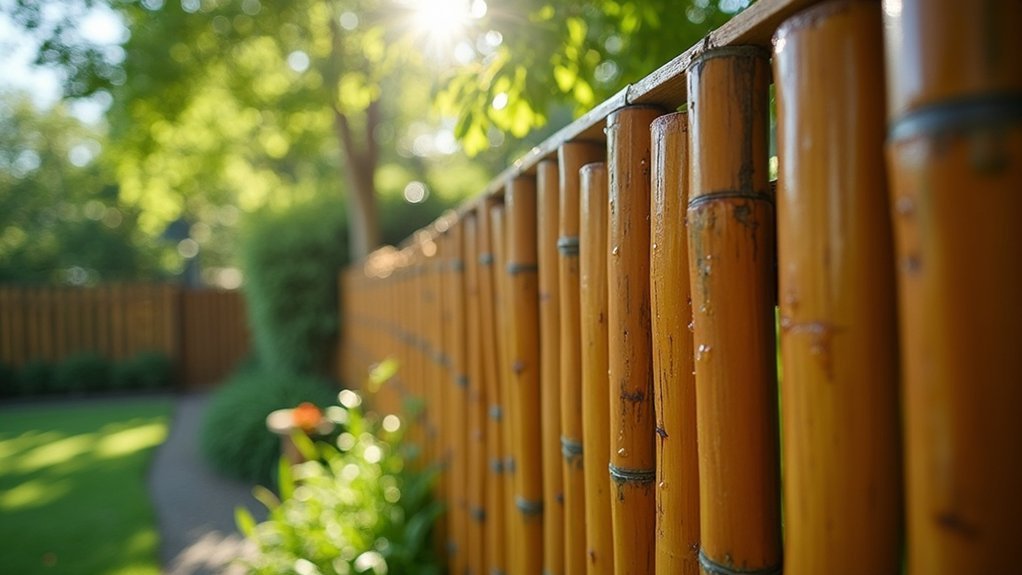
While traditional fence materials continue to dominate the market, weather-proof bamboo fencing has emerged as a compelling eco-friendly alternative that homeowners shouldn’t overlook.
By choosing bamboo, you’re selecting a truly sustainable resource that reaches maturity in just 3-5 years and regrows from its roots without replanting.
Bamboo redefines sustainability by maturing in just 3-5 years and regenerating naturally without replanting.
Unlike conventional fencing, bamboo requires no pesticides or herbicides and actually absorbs more carbon dioxide than equivalent tree stands.
The manufacturing process uses non-toxic phenolic resin instead of harmful chemical preservatives, creating a closed-loop system that prevents waste.
This approach results in fencing with markedly lower embodied energy than metal or plastic alternatives.
Your choice directly reduces deforestation pressure while supporting biodiversity preservation—practical benefits that complement bamboo’s natural tropical aesthetic.
Most homeowners appreciate that bamboo fencing is easy to install without requiring specialized equipment or professional contractors.
Cost-Benefit Analysis of Bamboo vs. Traditional Fencing Materials
You’ll find bamboo fencing costs $10-15 per linear foot upfront, considerably less than traditional wooden options while offering comparable durability.
The true savings become apparent over time, as bamboo requires minimal maintenance compared to wood’s regular staining, sealing, and potential replacement costs. Bamboo provides a more sustainable choice than conventional wood fencing due to its rapid growth rate and renewable nature.
When you consider this balance of initial investment versus lifetime expenses, bamboo emerges as the more economical choice for weather-resistant fencing that maintains its aesthetic appeal with minimal upkeep.
Initial vs. Lifetime Investment
When comparing bamboo fencing to traditional materials like wood or metal, the financial equation extends far beyond the initial price tag. You’ll typically spend less upfront on bamboo due to its rapid renewability, easier transportation, and simpler installation with preassembled panels.
While bamboo creates privacy quickly within 2-3 growing seasons, it’s important to evaluate long-term value. Though durable, bamboo may require more maintenance than metal or treated wood and generally has a shorter lifespan. These factors can increase your total ownership costs over time. Bamboo establishes a dense privacy screen in 2-3 growing seasons at half the cost of traditional fencing.
However, bamboo’s environmental benefits might offset these considerations. Its sustainability appeals to eco-conscious homebuyers, potentially boosting your property’s resale value.
You’re also reducing your carbon footprint and supporting biodiversity—advantages that traditional fencing materials simply can’t match.
Maintenance Cost Comparison
Beyond the initial purchase price, bamboo’s long-term maintenance costs reveal its true value compared to traditional fencing materials. You’ll find that bamboo fencing generally costs between $8-$28 per linear foot, making it more affordable than many alternatives while delivering comparable durability with proper care.
- Requires less frequent repairs than wood due to natural resistance to pests and rot
- Individual bamboo panels can be easily replaced, reducing overall repair expenses
- DIY-friendly maintenance needs fewer specialized skills, saving on professional service costs
- Withstands weather elements better than untreated wood, reducing weather-related damage costs
- Sustainable nature provides environmental benefits that potentially increase property appeal
While bamboo may not last as long as vinyl, its lower upfront cost and reduced maintenance requirements often result in better long-term value. Regular maintenance includes applying UV protection sealant every 2-3 years, which is less intensive than many competing fence materials.
Weather-Proofing Techniques for Maximum Bamboo Durability
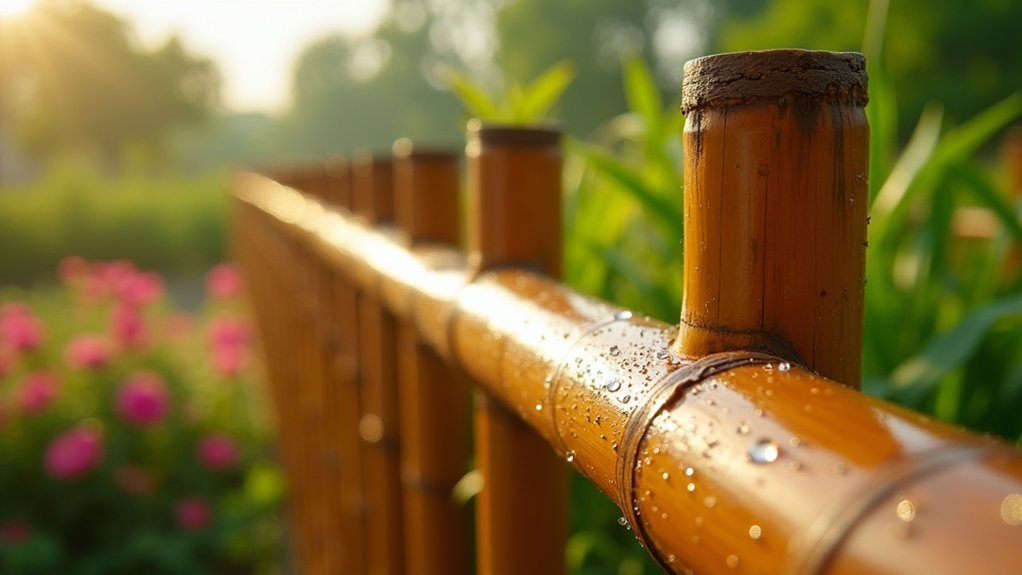
You’ll need to choose between chemical treatments and natural preservation methods to maximize your bamboo fence’s durability.
Chemical options like marine varnish and spar urethane provide superior protection against water and UV damage, while natural alternatives include elevating the fence to prevent ground moisture absorption.
Regular maintenance with either approach, including reapplication of sealants and cleaning with mild detergents, will greatly extend your fence’s lifespan. For optimal protection of new installations, be sure to seal immediately after setting up your bamboo fence to prevent cracking and moisture damage.
Chemical Treating Methods
To maximize the longevity of your bamboo fence, chemical treatments offer the most reliable defense against weathering and decay.
When selecting a treatment, you’ll need to take into account both location and environmental impact.
For outdoor fencing, you’ll find several effective options:
- Borax and boric acid mixtures provide excellent protection for moderate weather exposure while remaining environmentally friendly.
- CCA (Copper Chrome Arsenic) delivers superior long-term protection but should be avoided near gardens due to arsenic concerns.
- CCB (Copper Chrome Boron) offers a safer alternative to CCA while still providing robust protection.
- Hot immersion methods accelerate chemical penetration, ensuring thorough protection throughout the bamboo.
- Regular maintenance with UV-resistant sealants will extend the treatment’s effectiveness by years.
The soak immersion technique is particularly effective for large fencing projects as it allows for bulk treatment of multiple bamboo poles simultaneously.
Apply treatments before installation for complete protection against insects, moisture, and UV damage.
Natural Preservation Techniques
Natural preservation techniques offer a sustainable approach to weather-proofing bamboo fences while maintaining their inherent aesthetic appeal.
You’ll find borax solutions particularly effective, though they require reapplication after heavy rains.
Consider incorporating architectural elements like overhangs into your fence design to shield bamboo from direct precipitation.
Select bamboo species with naturally low starch content to minimize pest attraction.
Always elevate your fence on cement pilings to create a moisture barrier that prevents termite access.
Traditional methods like leaching, fermentation, and smoking can notably enhance durability without harsh chemicals.
Before applying any treatment, thoroughly clean and dry the bamboo’s surface.
Regular maintenance is essential—inspect your fence quarterly and address issues promptly.
Applying oil-based stains not only revives bamboo’s appearance but also provides essential UV protection against sun damage.
With proper elevation, species selection, and consistent care, you’ll enjoy a naturally preserved bamboo fence that stands the test of time.
Selecting the Right Bamboo Species for Your Climate
When creating a weather-proof bamboo fence, choosing species that match your local climate conditions is perhaps the most essential decision you’ll make.
The right bamboo variety guarantees longevity, minimal maintenance, and structural integrity through seasonal changes.
Consider these climate-specific recommendations:
- Cold regions (Zones 4-6): Choose Fargesia varieties like murielae or nitida for excellent frost tolerance and clumping habit
- Temperate areas (Zones 7-8): Opt for Phyllostachys aurea or nigra, which handle temperature fluctuations well
- Warm climates (Zones 9-11): Select Bambusa oldhamii or vulgaris for heat and humidity resistance
- Drought-prone regions: Look for evergreen species that maintain appearance during dry seasons
- Wet locations: Confirm proper drainage and select species that resist root rot
Your bamboo fence will thrive when the species matches your specific climate challenges. Additionally, well-managed bamboo species like Phyllostachys can sequester up to 24.31 tCO₂/ha of carbon annually, making your fence choice environmentally beneficial.
Installation Best Practices for Weather-Resistant Bamboo Fences
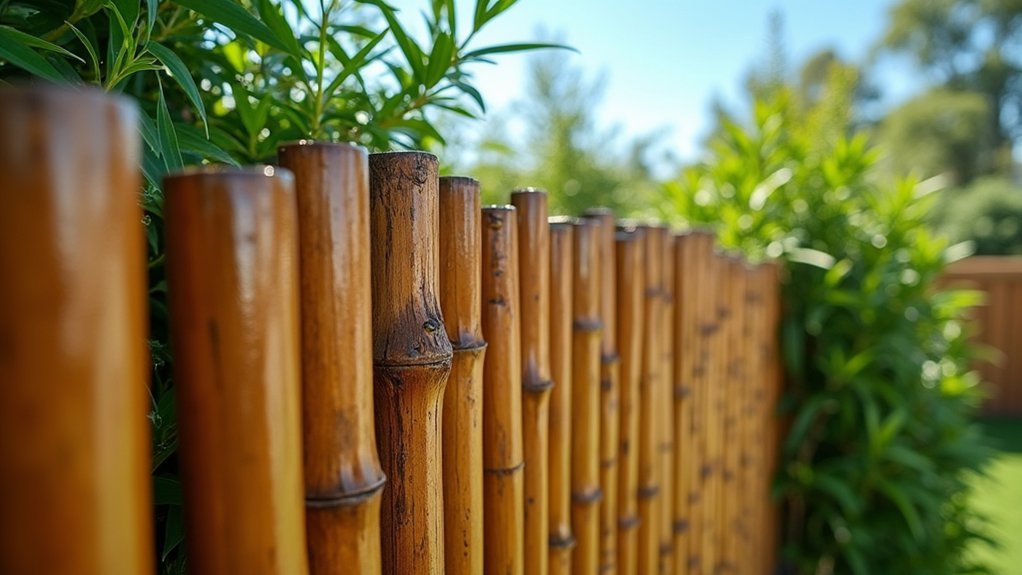
Installing a weather-resistant bamboo fence requires methodical planning and precise execution to assure long-term durability against the elements. Begin by carefully marking your fence line with consistent post spacing, considering wind patterns and sun exposure to minimize weathering. Choosing treated wood for support poles provides necessary durability against moisture and creates a stable foundation for your bamboo panels.
| Installation Phase | Key Action | Weather Protection Benefit |
|---|---|---|
| Site Preparation | Ascertain good drainage | Prevents water pooling and rot |
| Post Installation | Dig holes 1/3 post height | Maximizes stability in storms |
| Panel Mounting | Pre-drill holes every 12″ | Prevents cracking from moisture expansion |
| Weatherproofing | Apply UV-resistant sealant | Blocks sun damage and extends lifespan |
| Maintenance Setup | Install with 2″ ground clearance | Facilitates airflow and reduces moisture contact |
Remember to attach panels with corrosion-resistant screws and apply protective treatments before and after installation for maximum weather resilience.
Seasonal Maintenance Tips for Long-Lasting Bamboo Fences
Maintaining your bamboo fence throughout the year proves just as important as proper installation for achieving maximum durability and aesthetic appeal.
Your seasonal maintenance routine should adapt to changing weather conditions to protect your investment.
- Spring: Pressure wash gently (under 1,500 PSI) and check for winter damage, applying sealant before summer heat arrives.
- Summer: Keep vegetation trimmed 12+ inches away and monitor for insect activity, especially termites. Regular inspection for rust or corrosion on metal brackets can prevent structural weakening during humid months.
- Fall: Apply additional sealant in freeze-thaw climates and clear debris from the fence base.
- Winter: Inspect structural integrity of posts and tighten any loose fasteners.
- Year-round: Maintain 4-inch clearance between bamboo and soil to prevent moisture damage.
Remember to use mild cleaning solutions and sand rough areas before resealing to extend your fence’s lifespan.
Design Possibilities With Weather-Proof Bamboo Fencing
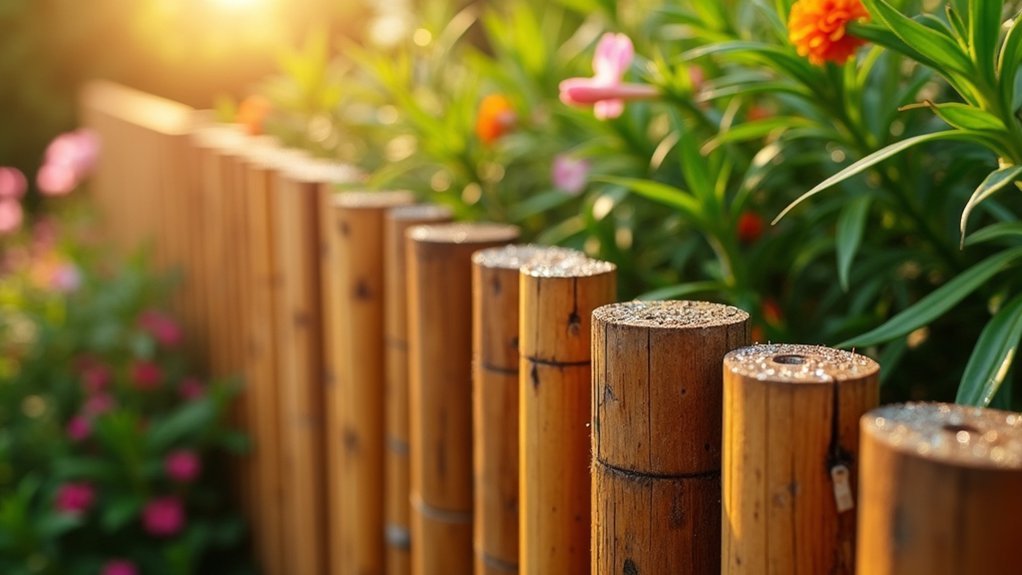
Weather-proof bamboo fencing offers a remarkable array of design possibilities that extend far beyond mere functionality.
You’ll find options ranging from natural whole bamboo panels that create rustic, breathable privacy screens to split bamboo fencing that delivers a more refined appearance while maintaining authentic charm.
For modern aesthetics, consider Tonkin bamboo with its sleek uniformity and superior strength, or make a bold statement with exotic black bamboo that adds luxurious appeal to outdoor settings.
The versatility doesn’t end there – you can combine bamboo with wood, metal, or stone for unique mixed-media barriers.
Experiment with different configurations: horizontal, vertical, or diagonal placements work beautifully for freestanding fences, privacy screens, or garden dividers.
With various finishes available, your weather-proof bamboo fence can complement any architectural style.
These eco-friendly barriers can significantly enhance your outdoor space by providing cooling effects that reduce dependency on air conditioning during hot California summers.
Enhancing Property Value With Sustainable Bamboo Boundaries
The strategic addition of sustainable bamboo boundaries can considerably boost your property’s market appeal and financial value while supporting eco-friendly practices.
Eco-friendly bamboo boundaries enhance property value while demonstrating environmental consciousness—a dual investment in aesthetics and sustainability.
Weather-proof bamboo fencing represents a wise investment that often recoups around 50% of installation costs through increased property valuation.
- Bamboo’s unique natural aesthetic creates distinctive curb appeal that immediately attracts potential buyers.
- As the fastest-growing plant on earth, bamboo signals your commitment to sustainability—increasingly valued in today’s real estate market.
- Treated bamboo solutions offer exceptional durability with minimal maintenance, enhancing long-term investment value.
- 33% of millennial homebuyers are specifically influenced by the presence of attractive fencing when purchasing.
- The harmonious integration of bamboo with your landscaping creates a seamless connection between built and natural environments.
Bamboo fencing is considered a cost-effective option compared to more expensive materials like vinyl or brick while still providing adequate privacy for your outdoor spaces.
Real-World Success Stories: Bamboo Fences in Extreme Climates
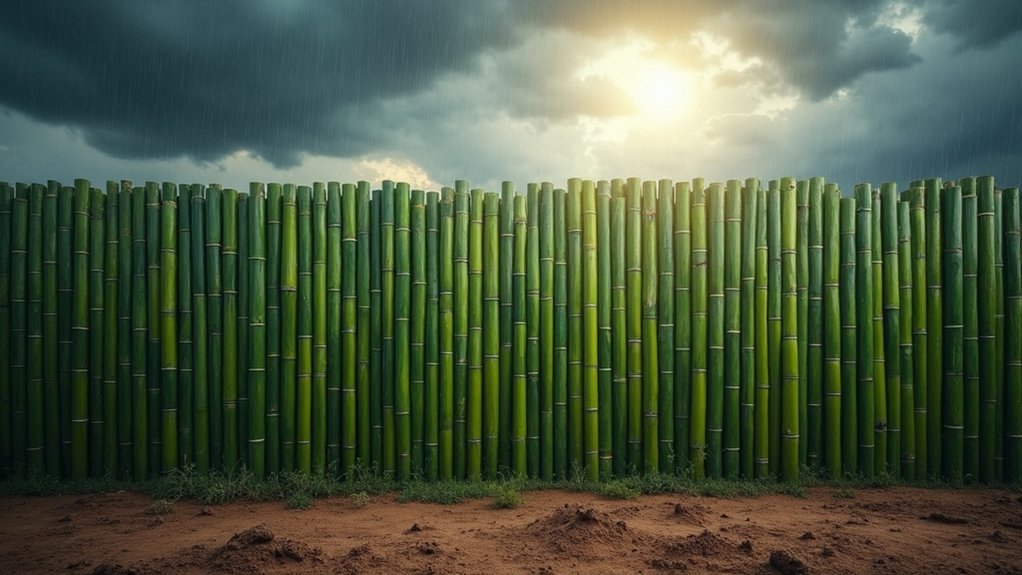
Beyond enhancing property value, bamboo fences have proven their remarkable resilience under some of Earth’s most challenging weather conditions.
You’ll find bamboo structures on stilts in flood-prone regions, cleverly elevated to avoid rising waters while maintaining stability.
In tropical storm zones, bamboo’s natural flexibility allows fences to bend with powerful winds rather than break. This adaptability extends to temperature extremes—bamboo resists splitting and cracking whether in desert heat or frigid cold. Bamboo’s ability to thrive on degraded soils makes it an excellent choice for fencing in areas with poor soil quality.
Luxury resorts in harsh coastal environments showcase bamboo’s dual benefits of weather resistance and aesthetic appeal.
Meanwhile, community-driven projects near polluted waterways utilize bamboo fencing as natural pollution barriers. These installations demonstrate bamboo’s impressive tensile strength and fire resistance, offering practical solutions that simultaneously contribute to carbon sequestration efforts.
Frequently Asked Questions
Can Bamboo Fencing Attract Wildlife or Invasive Insects?
Your bamboo fencing doesn’t actively attract wildlife or invasive insects. It’s neutral rather than a deterrent, though it may provide habitat for small insects without specifically drawing in invasive species.
How Does Bamboo Fencing Sound During Rain or Wind?
You’ll hear gentle rustling and creaking when wind passes through your bamboo fence. During rain, it creates a soothing, rhythmic pattering sound as droplets hit the surface, creating a natural, tranquil soundscape.
Will Bamboo Fencing Affect My Home Insurance Rates?
Bamboo fencing typically won’t greatly impact your home insurance rates. Insurers focus more on your location, home’s condition, and security systems than fence type when calculating premiums. It’s considered a minor property feature.
Can Bamboo Fencing Be Combined With Security Features?
Yes, you can enhance bamboo fencing with security features like metal frames, alarm systems, motion sensors, and cameras. It’s also possible to integrate additional barriers or protective supports to greatly improve your property’s security perimeter.
Is Bamboo Fencing Suitable for Properties With Swimming Pools?
Yes, bamboo fencing is ideal for your pool area. It’s durable in wet conditions, adds tropical aesthetic appeal, and can help with pool certification requirements while being eco-friendly and cost-effective for your property.
In Summary
By choosing weather-proof bamboo fencing, you’ll embrace an eco-friendly, cost-effective alternative that stands up to the elements while adding natural beauty to your property. With proper selection, installation, and maintenance, your bamboo fence will provide years of sustainable service regardless of climate challenges. It’s an investment that balances environmental consciousness with practical durability—proving that you don’t need to sacrifice style for weather resistance.

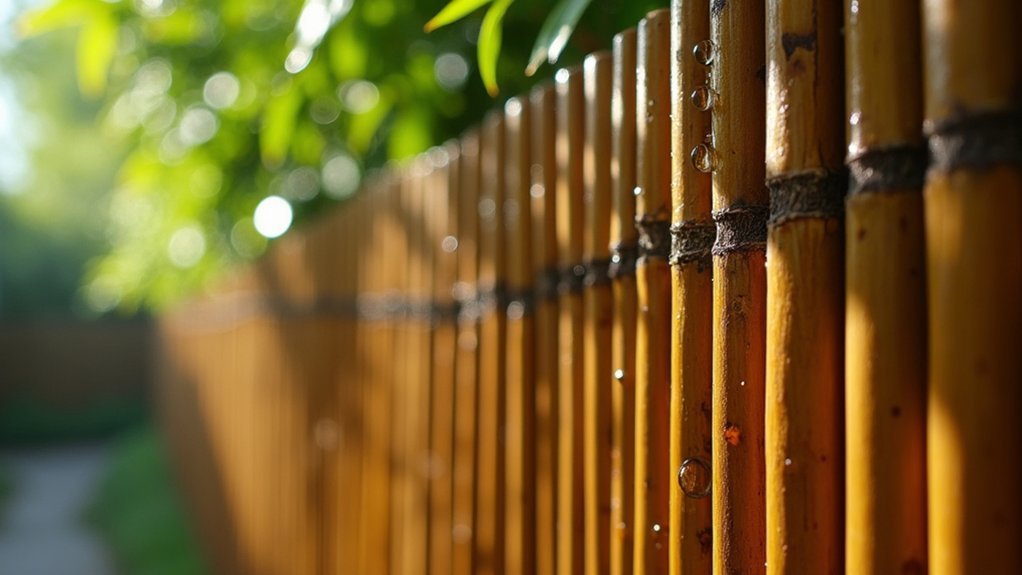



Leave a Reply